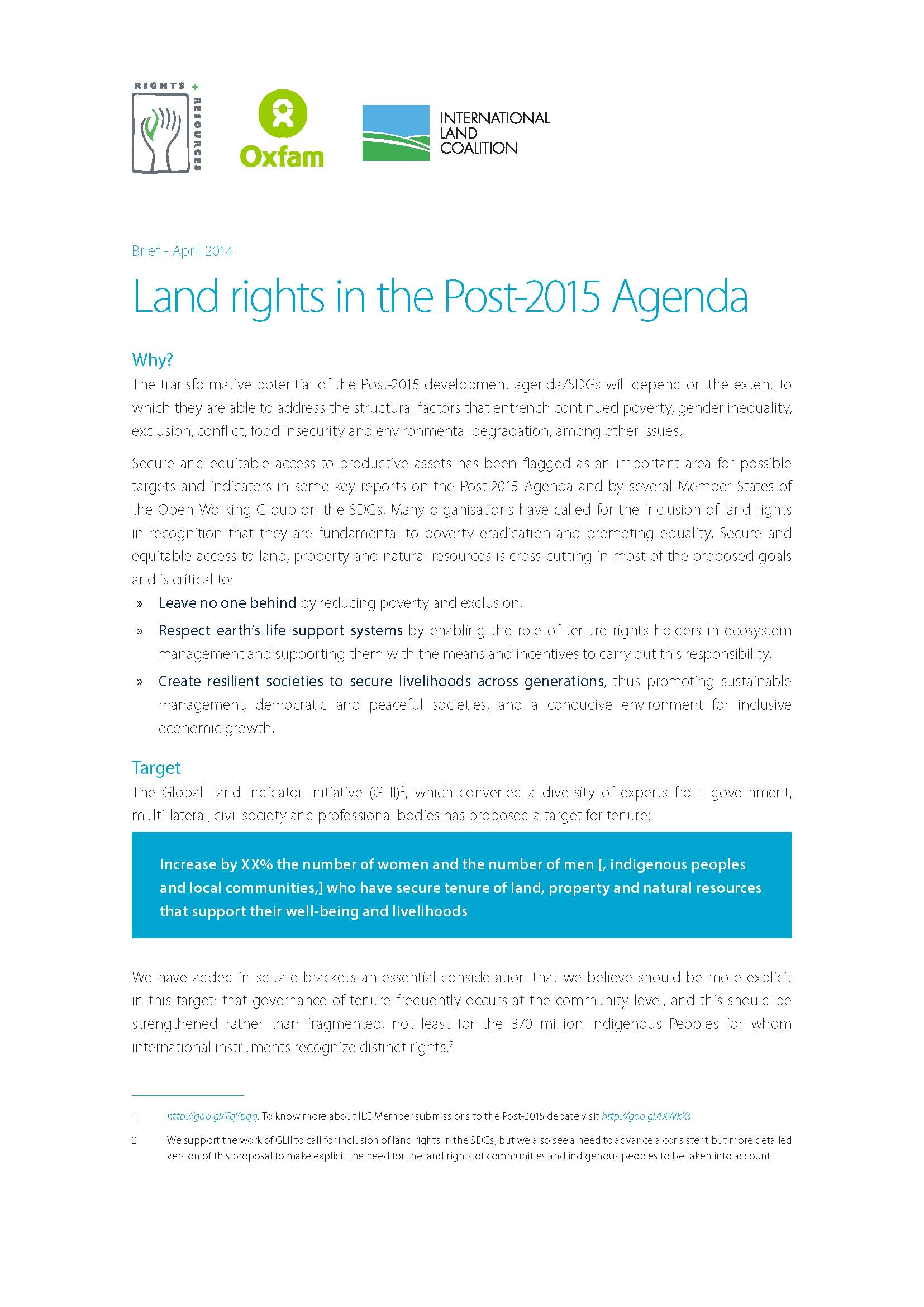Resource information
A new policy brief released by the Rights and Resources Initiative (RRI), Oxfam, and the Secretariat of the International Land Coalition (ILC) calls for the inclusion of “community land rights” in the United Nations’ Post-2015 Development Agenda, terming it critical to eradicating poverty and respecting earth’s life support systems.
The UN’s Millennium Development Goals are set to expire in 2015, and the development of the goals that should follow them is currently underway by the Open Working Group on Sustainable Development Goals (SDGs).
Ownership of over one-half of the developing world’s rural, forest and dryland areas is contested, directly affecting the lives and livelihoods of over two billion people. These people often have no formal title to the lands on which they live and depend, and rarely have the means to defend the rights they do possess. This lack of protection becomes especially evident and cause for conflict when private enterprises acquire land and/or resources from governments without addressing who lives there.
“Community land rights are not just a national or a regional problem; they call for global attention,” said Jenny Springer, Director of Global Programs for the Rights and Resources Initiative. “The urgency to address this issue has only increased with the sharply rising demand for resources. Without a dramatic step up in efforts to recognize these rights not only are billions of people’s livelihoods at stake, but so is global progress on addressing poverty, conflict, and climate change.”
The brief—prepared by RRI, Oxfam, and the ILC, the world’s largest networks of organizations active on forest and land rights—follows an earlier call to action by the organizations at an international conferenceon community land and resource rights held in September, 2013, which called for a doubling of the amount of land recognized as owned or controlled by Indigenous Peoples and local communities by 2018. The conference also emphasized the need to rapidly recognize all land under indigenous or customary management, which has not yet received adequate international attention.
The three organizations have been collaborating since March, 2013 in pursuance of a common goal to bring global attention to the unprecedented threats to the tenure security of the world’s poor, in parallel to the importance of land rights to development, food security, environmental stewardship, cultural survival and dignity, and climate change mitigation.
The RRI, Oxfam and ILC brief expands on a proposed target and indicators for tenure put forth by the Global Land Indicator Initiative (GLII) and recommends a target to:
“Increase by XX% the number of women and the number of men, indigenous peoples and local communities, who have secure tenure of land, property and natural resources that support their well‑being and livelihoods.”
This brief comes at a point when several Member States of the Open Working Group on the SDGs have already identified secure and just access to productive assets as an important area for possible targets and indicators. The report of the High Level Panel of Eminent Persons on the Post-2015 Development Agenda also proposed targets on “secure rights to land, property, and other assets” as a building block to end poverty, and on land and property rights for women. Furthermore, many leading advocacy organizations have called for the inclusion of land rights in recognition that they are fundamental to poverty eradication and promoting equality. The inclusion becomes all the more significant because communities’ access to land, property, and natural resources is cross-cutting in most of the proposed goals.
“We predict that this target is capable of capturing a wide array of concerns related to land rights in rural and urban settings,” said Duncan Pruett, Policy Advisor on Land Rights for Oxfam. “It also captures the need to ensure greater gender equality and a transformative agenda reaches those most reliant on land-based resources, as well as the broad consensus reached through the Voluntary Guidelines on the Responsible Governance of Tenure of Land, Fisheries and Forests, and the Framework and Guidelines for Land Policy in Africa.”
Two of the indicators proposed address the importance of community tenure in building strong, sustainable and prosperous local societies, recognizing the diversity of tenure systems:
- Area of land legally recognized under the tenure of indigenous peoples and local communities.
- Extent to which the national legal framework recognizes and protects land tenure rights and uses derived through a plurality of tenure regimes, in line with international standards.
“We believe that highlighting the grave global crisis facing Indigenous Peoples and local communities in the Post-2015 Development Agenda will go a long way in convincing key actors—such as governments and the private sector—to join the fight for community land rights,” said Andy White, coordinator of the Rights and Resources Initiative. “The time for action is now—the dreams and aspirations of hundreds of millions of people who are the customary owners of their land and resources cannot and will not be ignored.”
- - -
Read the original article here
Find the document attached

